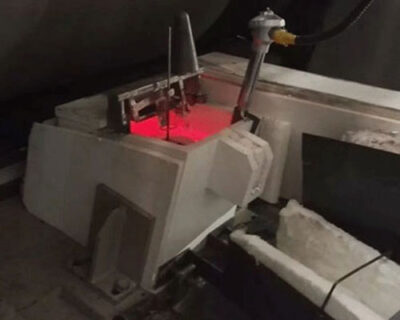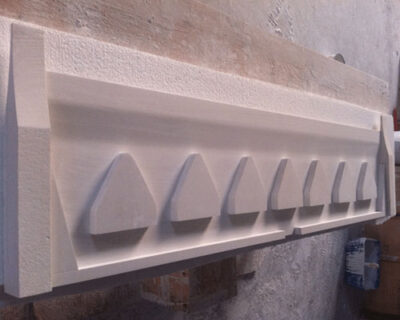In a vertical continuous casting machine, where the axis of the roller is in a horizontal plane, and molten metal is fed upward into the gap between the rollers. The plane of the feed tip is inclined upward by about 15° with respect to the horizontal direction, so that the molten metal is fed upward into the gap between the rollers.
The downstream edges of the caster tip are spaced apart to provide a continuous gap extending along the length of the roll, the total length of the gap approximately corresponding to the desired width of the cast sheet. The conventional flared end baffle closes the end of the feed tip and helps determine the width of the cast sheet. The width of the sheet prepared in the manufacturing operation sometimes varies, and the maximum value depends on the length of the roll. The width is usually 11/2 to 2 meters. Therefore, the molten metal caster tip is made into multiple segments, each segment typically extending about 15 cm along the length of the roll. Therefore, a larger or smaller number of segments can be assembled to form a molten metal feed port of the required width of the continuous casting machine.

Generally, the spacer between the upstream portions of the two halves of the feed tip is sufficient to maintain the desired gap between the downstream edges of the caster tip. If necessary, one or more additional spacers can be provided at an intermediate position between the upstream portion and the downstream edge. Such spacers, if used, should be reasonably streamlined to avoid interference with the metal flow through the feed end.
The space between the spacers provides a means for the liquid metal to enter the gap between the two halves of the feed tip. The cross-sectional area of the space at the upstream portion of the metal flow-through tip is preferably greater than the cross-sectional area of the gap between the downstream edges of the metal flow-through tip. This ensures that the metal velocity increases rather than decelerates as it flows through the tip. The substantially straight taper of the gap through which molten metal flows between the upstream portion and the downstream edge is also ideal to minimize sudden changes in the velocity of the metal flowing through the tip of the continuous caster. Such an arrangement can minimize the discontinuity of the metal flow and avoid the introduction of impurities in the sheet formed by the continuous casting machine. The substantially flat inner surface also allows the member to be thicker in the area near the downstream edge and increase strength.

